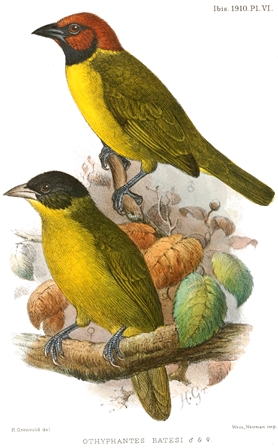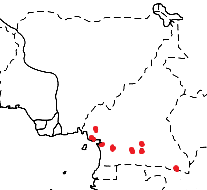Weaver Wednesday [88]: Bates's Weaver 2014-02-19 (486)
 Weaver Wednesday
Weaver Wednesday

The Bates's Weaver Ploceus batesi male is green above and yellow below, with a unique head pattern that consists of a rich chestnut crown and face with a black throat. The female has a black crown and face, and yellow throat. The juvenile resembles the female, but the head is pale olive-green, not black, and the bill is horn-brown instead of black.
The Bates's Weaver is restricted to a few localities in southern Cameroon's lowland rainforest (see map below, based on Birds of Africa). There are no subspecies of the Bates's Weaver. It is listed as ENDANGERED, due to its rarity. The estimated global population is less than 1000 individuals, and it is probably declining due to habitat loss. It has been recorded only at nine sites in a narrow belt from Limbe east to Moloundou.
In recent years, it has been seen on Mt Kupe (twice in 1990) but not since, in spite of intensive searches. It has been seen near the Dja reserve (at Somalomo in 1995 and at Shwani, 12 km from Somalomo, in 1996).
The rarity of Bates's Weaver is a mystery; it may be due to the loss of some specific habitat feature but the species was already rare when it was discovered in 1906.

The Bates's Weaver inhabits lowland rainforest, up to 900 m on Mt Kupe.
The Bates's Weaver feeds on insects. It forages singly, or in pairs, and once was seen in a mixed-species flock of insectivorous birds. It moves in a zig-zag manner up creeper-covered tree-trunks.
There is no information on the breeding biology of the Bates's Weaver and the nest and eggs are undescribed.
There are no PHOWN records for the Bates's Weaver yet (see PHOWN summary) - be the first to find its nest! Submit any weaver nest records to PHOWN (PHOtos of Weaver Nests) via the Virtual Museum upload site.
PHOWN summary
Previous Wedn: Rodrigues Fody
Full weaver species list
| 

 Weaver Watch
Weaver Watch


